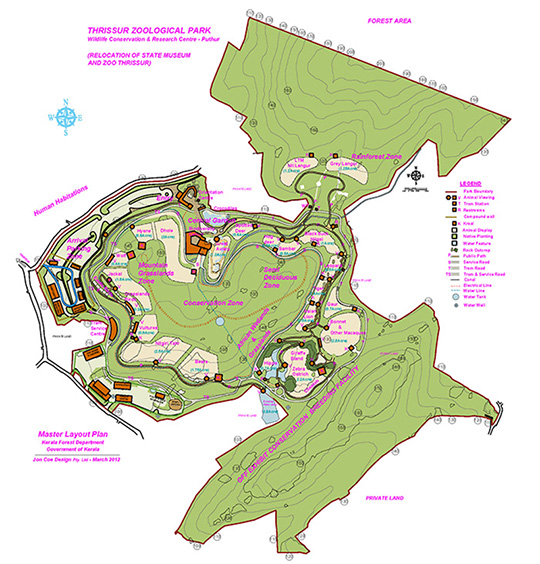Thrissur Zoo
Thrissur Zoo 2009

The entire site is shown in the plan above.

The central area plan above.
Not all international zoo planning and development experiences go well. In 2009 I was invited to prepare a master development plan for a major new zoo in the town of Thrissur, State of Kerala in the south of India by their Environment and Forest Department of Kerala. This new zoo was proposed to replace a Victorian Era zoo, creating large, beautiful, and enriching habitats for the animals then in old cages, plus my new species. The planning and design stages went well due to the outstanding skill and collaboration of colleagues from Idea Design, an outstanding landscape architecture and architecture firm based in nearby Cochin. The site provided was very steep with frequent huge hard granite outcrops and would be difficult and expensive to develop. As with other sites, I carried out most of the planning while walking the land with the client’s team and my colleagues with representatives of the local community.

Wise local people relax during the heat of the afternoon and were not used to foreigners like me impatiently hiking up, down and across this tropical site all afternoon. (Photos: Diamond Paul).
In the West designers are used to working with expert zoo directors and staff, supporting the zoo’s goals and objectives. In many areas of Asia government clients say: “You are the paid international expert, so tell us what to do.” I became concerned during planning when the client refused to recruit a new director or curator for the project for us to work with and ignored my plea to begin training local workers to become professional zoo staff, programs which could take longer than construction. I was wrong about the time it takes to fund and build public works in India. Our Master Plan was approved by the Central Zoo Authority (CZA) of India, who control all zoos, and the Environment and Forest Department of Kerala (EFDK) in 2012, over two years after we completed the plan. Our team was then contracted to prepare complete detailed designs and construction documents with periodic reviews and revisions required by the CZA whose elders are quite conservative. Nevertheless, we were able to incorporate some modern innovations such as spacious off-exhibit exercise yards for all animals when not on exhibit and after operating hours. Idea Design did excellent, patient work producing thorough documentation of my rough sketches for exhibits, service areas, building, aviaries, water features, roads, and walkways. However, our contract did not include oversight during construction, so we had no control over how our plans were interpreted and built.
Eventually construction began by work crews from the EFDK, and continues to this day, a decade since we began.
Lessons learned: avoid large government works at home and abroad, where both ministers and project managers change multiple time during the project. Don’t undertake design projects for which you have no control over the quality and appropriateness of the final construction.